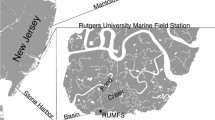Abstract
In July, 1979, a series of 12 transplant experiments was begun using Goniobasis proxima (Say), a freshwater snail living in highly isolated populations in the southern Appalachians. At each site, 500 native snails were removed and replaced with 500 snails from a second population in which different alleles were fixed at one or two enzyme loci. The sites were resampled in 1983 to identify populations where the introduced genome had in fact become established. Only two of the twelve introductions were successful. Introduced genes have spread about 15–20 meters per year upstream and 5–10 meters per year downstream. Considering observed population sizes and age-specific survivorships, it appears that the observed frequencies of the introduced genomes at both sites are significantly greater than expected from simple diffusion. A selective advantage for the introduced snails or their F1 progeny seems likely. This implies that the genetic differences between G. proxima populations may in some cases be due to random processes.
Similar content being viewed by others
References
Bailey, N. J. T., 1951. On estimating the size of mobile populations from recapture data. Biometrika 38: 293–306.
Barker, J. S. F. & East, P. D., 1980. Evidence for selection following perturbation of allozyme frequencies in a natural population of Drosophila. Nature 284: 166–168.
Begon, M., 1979. Investigating animal abundance: Capture-Recapture for Biologists. Edward Arnold, London.
Burton, R. S., 1987. Differentiation and integration of the genome in populations of the marine copepod Tigriopus californicus. Evolution 41: 504–513.
Calow, P., 1978. The evolution of life cycle strategies in freshwater gastropods. Malacologia 17: 351–364.
Dazo, B. C., 1965. The morphology and natural history of Pleurocera acuta and Goniobasis livescens (Gastropoda: Cerithiacea: Pleuroceridae). Malacologia 3: 1–80.
Dillon, R. T., Jr., 1982. The correlates of divergence in isolated populations of the freshwater snail, Goniobasis proxima. Ph.D. Thesis, Univ. Pennsylvania, Philadelphia.
Dillon, R. T.Jr., 1984a. Geographic distance, environmental difference, and divergence between isolated populations. Syst. Zool. 33: 69–82.
Dillon, R. T.Jr., 1984b. What shall I measure on my snails? Allozyme data and multivariate analysis used to reduce the nongenetic component of morphological variance in Goniobasis proxima. Malacologia 25: 503–511.
Dillon, R. T.Jr., 1985. Correspondence between the buffer systems suitable for electrophoretic resolution of bivalve and gastropod isozymes. Comp. Bioch. Physiol. 82B: 643–645.
Dillon, R. T.Jr., 1986. Inheritance of isozyme phenotype at three loci in the freshwater snail, Goniobasis proxima: Mother-offspring analysis and an artificial introduction. Biochem. Genet. 24: 281–290.
Dillon, R. T.Jr. & Davis, G. M., 1980. The Goniobasis of southern Virginia and northwestern North Carolina: Genetic and shell morphometric relationships. Malacologia 20: 83–98.
Dubinin, N. P. & Tiniakov, G. C., 1946. Inversion gradients and natural selection in ecological races of Drosophila funebris. Genetics 31: 537–545.
Dobzhansky, T., 1950. Genetics of natural populations. XIX. Origin of heterosis through natural selection in populations of Drosophila pseudoobscura. Genetics 35: 288–302.
Endler, J. A., 1977. Geographic variation, speciation, and clines. Princeton Univ. Press, Princeton.
Endler, J. A., 1986. Natural selection in the wild. Princeton Univ. Press, Princeton.
Ford, E. B. & Sheppard, P. M., 1969. The medionigra polymorphism of Panaxia dominula. Heredity 24: 561–659.
Greenwood, J. J. D. & Parkin, D. T., 1984. A transplantation experiment on two species of helicid snails in northern Scotland. Malacologia 25: 303–313.
Halkka, O., Halkka, L. & Raatikainen, M., 1975. Transfer of individuals as a means of investigating natural selection in operation. Hereditas 80: 27–34.
Jain, S. K. & Rai, K. N., 1980. Population biology of Avena. VIII. Colonization experiment as a test of the role of natural selection in population divergence. Am. J. Bot. 67: 1342–1346.
Jokinen, E. H., 1985. Comparative life history patterns within a litteral zone snail community. Verh. int. Verein. Limnol. 22: 3292–3299.
Jones, J. S. & Parkin, D. T., 1977. Experimental manipulation of some snail populations subject to climate selection. Am. Natur. 111: 1014–1017.
Mancini, E. R., 1978. The biology of Goniobasis semicarinata (Say) in the Mosquito Creek drainage system, southern Indiana. Ph.D. Thesis, Univ. Louisville, Louisville, Kentucky.
Manly, B. F. J., 1985. The statistics of natural selection on animal populations. Chapman and Hall, London.
Poulik, M. D., 1957. Starch gel electrophoresis in a discontinuous system of buffers. Nature 180: 1477–1479.
Robson, D. S. & Regler, H. A., 1964. Sample size in Petersen mark recapture experiments. Trans. Am. Fish. Soc. 93: 215–226.
Sheppard, P. M. & Cook, L. M., 1962. The manifold effects of the Medionigra gene on the moth Panaxia dominula (L.). Heredity 17: 415–426.
Siegel, S., 1956. Nonparametric statistics for the social sciences. McGraw-Hill, New York.
Stiven, A. E. & Walton, C. R., 1967. Age and shell growth in the freshwater snail, Goniobasis proxima (Say). Am. Midl. Nat. 78: 207–214.
Wallace, B., 1981. Basic population genetics. Columbia Univ. Press, New York.
Author information
Authors and Affiliations
Rights and permissions
About this article
Cite this article
Dillon, R.T. Evolution from transplants between genetically distinct populations of freshwater snails. Genetica 76, 111–119 (1988). https://doi.org/10.1007/BF00058809
Received:
Accepted:
Issue Date:
DOI: https://doi.org/10.1007/BF00058809




